
|
Now it is very bright as 11.5 mag (May 24, Michael Jager). It brightens up to 11.5 mag from May to June. However, it locates very low in the Northern Hemisphere. It is not observable in the Southern Hemisphere.
Date(TT) R.A. (2000) Decl. Delta r Elong. m1 Best Time(A, h)
May 25 3 48.90 59 57.4 1.922 1.306 39 11.7 5:25 (216,-32)
June 1 4 51.59 59 40.0 1.935 1.294 37 11.6 18:26 (144,-31)
|
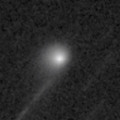
|
Appearing in the morning sky in the Southern Hemisphere. It will appear in the morning sky in late June in the Northern Hemisphere. It will brighten up to 10.5 mag and it will be observable in good condition from autumn to winter.
Date(TT) R.A. (2000) Decl. Delta r Elong. m1 Best Time(A, h)
May 25 2 12.19 0 34.6 4.319 3.527 34 12.7 5:25 (258, 16)
June 1 2 16.87 2 1.5 4.231 3.497 38 12.6 5:29 (252, 20)
|

|
Now it is not observable. It will appear in the morning sky again at 13-14 mag in August.
Date(TT) R.A. (2000) Decl. Delta r Elong. m1 Best Time(A, h)
May 25 4 10.39 18 39.7 3.070 2.059 2 12.7 18:28 (102,-16)
June 1 4 27.46 19 11.1 3.083 2.072 3 12.8 5:29 (257,-15)
|

|
It brightened up to 7.7 mag in June in 2018 (June 19, Juan Jose Gonzalez). Now it is fading. But it is still bright as 12.9 mag (May 6, Chris Wyatt). In the Southern Hemisphere, it stays observable for a long time until the comet will fade out. In the Northern Hemisphere, it is not observable for a long time until autumn when the comet fades out down to 16 mag.
Date(TT) R.A. (2000) Decl. Delta r Elong. m1 Best Time(A, h)
May 25 5 37.80 -34 1.0 4.249 3.829 59 13.2 18:28 ( 67, 30)
June 1 5 45.61 -32 50.5 4.336 3.886 57 13.3 18:26 ( 67, 26)
|

|
Now it is 12.8 mag (May 8, Chris Wyatt). It stays 13-14 mag until summer. It is observable in excellent condition in the Southern Hemisphere. In the Northern Hemisphere, it will be getting lower gradually, and it will be unobservable in July.
Date(TT) R.A. (2000) Decl. Delta r Elong. m1 Best Time(A, h)
May 25 15 28.76 -41 50.3 2.510 3.468 157 13.4 23:16 ( 0, 83)
June 1 15 9.46 -42 34.2 2.557 3.491 152 13.5 22:30 ( 0, 82)
|

|
Appearing in the morning sky. Now it is bright as 13.7 mag (May 8, Chris Wyatt).
Date(TT) R.A. (2000) Decl. Delta r Elong. m1 Best Time(A, h)
May 25 0 38.08 11 30.5 6.362 5.768 50 13.7 5:25 (232, 26)
June 1 0 42.06 12 4.6 6.276 5.768 55 13.7 5:29 (226, 30)
|
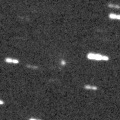
|
Now it is bright as 13.5 mag (May 7, Thomas Lehmann). It stays 13 mag for a long time in 2019. In the Southern Hemisphere, it is observable in excellent condition. In the Northern Hemisphere, it is not observasble until summer in 2020.
Date(TT) R.A. (2000) Decl. Delta r Elong. m1 Best Time(A, h)
May 25 7 25.31 -52 31.2 2.963 3.051 85 13.8 18:28 ( 47, 52)
June 1 7 27.27 -52 14.1 2.989 3.042 83 13.8 18:26 ( 48, 48)
|

|
It approached to Earth down to 0.3 a.u. in mid February, and brightened up to 5.5 mag (Feb. 13, Juan Jose Gonzalez). Now it is fading. It has already faded down to 13.0 mag (Apr. 24, M. Lehky). Now it is not observable. It will appear in the morning sky in July in the Northern Hemisphere, or in August in the Southern Hemisphere.
Date(TT) R.A. (2000) Decl. Delta r Elong. m1 Best Time(A, h)
May 25 4 34.27 34 33.5 2.964 2.005 15 13.9 18:28 (119,-20)
June 1 4 36.62 34 53.4 3.052 2.077 12 14.2 18:26 (117,-24)
|

|
It is expected to brighten up to 7 mag in 2020. Now it is not observable. It will appear in the morning sky in July.
Date(TT) R.A. (2000) Decl. Delta r Elong. m1 Best Time(A, h)
May 25 3 53.61 11 47.3 5.368 4.372 9 14.2 5:25 (263,-11)
June 1 3 59.56 12 33.3 5.292 4.307 12 14.1 5:29 (259, -6)
|
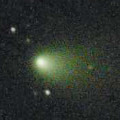
|
Now it is 13.4 mag (May 6, Chris Wyatt). It is observable in excellent condition in the Northern Hemisphere. It locates somewhat low in the Southern Hemisphere.
Date(TT) R.A. (2000) Decl. Delta r Elong. m1 Best Time(A, h)
May 25 11 19.07 16 42.9 1.877 2.290 100 14.5 19:09 (180, 38)
June 1 11 25.53 14 54.8 1.970 2.310 96 14.7 18:48 (180, 40)
|
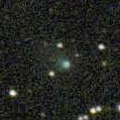
|
It is expected to brighten up to 10 mag in autumn. Now it is 14.2 mag (May 12, Thomas Lehmann). In the Northern Hemisphere, it stays observable for a long time while the comet is brightening. In the Southern Hemisphere, it it not observable until mid September.
Date(TT) R.A. (2000) Decl. Delta r Elong. m1 Best Time(A, h)
May 25 4 1.06 65 32.9 2.631 2.040 44 14.7 5:25 (210,-34)
June 1 4 7.33 64 25.8 2.599 1.977 42 14.5 5:29 (210,-32)
|

|
Now it is 14.4 mag (May 8, Chris Wyatt). In the Southern Hemisphere, it is observable for a long time. In the Northern Hemisphere, it will never be observable again.
Date(TT) R.A. (2000) Decl. Delta r Elong. m1 Best Time(A, h)
May 25 0 15.95 -45 27.5 4.014 4.039 84 14.8 5:25 (301, 58)
June 1 0 20.62 -45 11.3 3.955 4.054 88 14.8 5:29 (302, 62)
|
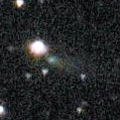
|
Now it is 14.8 mag (May 10, Katsumi Yoshimoto). It brightens up to 15 mag from May to June, and it will be observable in good condition.
Date(TT) R.A. (2000) Decl. Delta r Elong. m1 Best Time(A, h)
May 25 22 41.92 28 48.7 1.567 1.588 72 15.0 5:25 (196, 24)
June 1 23 0.40 31 46.4 1.567 1.601 73 15.0 5:29 (193, 22)
|

|
Now it is 14.2 mag (May 7, Thomas Lehmann). It will be fading after this. In the Southern Hemisphere, it stays observable for a long time until it fades out. In the Northern Hemisphere, it will not be observable after this.
Date(TT) R.A. (2000) Decl. Delta r Elong. m1 Best Time(A, h)
May 25 5 53.07 -20 21.8 4.702 4.108 48 15.5 18:28 ( 83, 27)
June 1 5 57.07 -20 44.5 4.778 4.158 47 15.6 18:26 ( 80, 22)
|

|
Now it is 15.9 mag (May 4, Toshihiko Ikemura, Hirohisa Sato). It will be fading slowly after this. It is observable in good condition in the Northern Hemisphere. In the Southern Hemisphere, it stays extremely low for a while.
Date(TT) R.A. (2000) Decl. Delta r Elong. m1 Best Time(A, h)
May 25 15 1.43 45 41.8 4.123 4.598 111 15.5 22:50 (180, 9)
June 1 14 55.88 44 38.2 4.208 4.651 109 15.7 22:17 (180, 11)
|

|
Now it is 16.4 mag (May 2, Toshihiko Ikemura, Hirohisa Sato). It will brighten rapidly after this. It will be observable at 13.5 mag in good condition in autumn.
Date(TT) R.A. (2000) Decl. Delta r Elong. m1 Best Time(A, h)
May 25 17 47.93 -5 21.1 1.497 2.431 150 15.8 1:41 (180, 60)
June 1 17 44.76 -4 41.4 1.429 2.389 155 15.6 1:10 (180, 60)
|

|
Now it is 16.1 mag (Apr. 27, Toshihiko Ikemura, Hirohisa Sato). It will be fading slowly after this. It will be getting lower gradually after this, and it will be unobservable in June.
Date(TT) R.A. (2000) Decl. Delta r Elong. m1 Best Time(A, h)
May 25 8 44.05 35 8.7 5.826 5.426 62 15.9 18:28 (156, 15)
June 1 8 44.61 34 21.2 5.970 5.467 55 16.0 18:26 (151, 14)
|
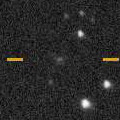
|
Now it is 16.6 mag (May 10, Mount John Observatory, Lake Tekapo). It stays 16 mag for a long time from 2019 to 2020. It is observable in excellent condition in the Southern Hemisphere. It is hardly observable in the Northern Hemisphere.
Date(TT) R.A. (2000) Decl. Delta r Elong. m1 Best Time(A, h)
May 25 11 23.02 -56 51.7 3.291 3.870 117 16.0 19:12 ( 0, 68)
June 1 11 13.38 -56 10.6 3.322 3.842 113 16.0 18:35 ( 0, 69)
|
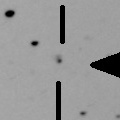
|
Asteroid, but it brightened rapidly. Now it is 16.9 mag (Mar. 27, iTelescope Observatory, Siding Spring). It is observable in excellent condition in the Southern Hemisphere. It is hardly observable in the Northern Hemisphere.
Date(TT) R.A. (2000) Decl. Delta r Elong. m1 Best Time(A, h)
May 25 22 21.90 -37 50.6 6.217 6.460 99 16.3 5:25 (289, 80)
June 1 22 18.55 -38 21.3 6.098 6.455 106 16.2 5:29 (320, 86)
|

|
It brightened up to 14 mag from autumn to winter in 2018. Now it is fading. It is observable in excellent condition in the Northern Hemisphere. It locates extremely low in the Southern Hemisphere.
Date(TT) R.A. (2000) Decl. Delta r Elong. m1 Best Time(A, h)
May 25 10 12.28 42 46.8 2.826 2.785 77 16.3 18:28 (175, 12)
June 1 10 20.02 40 23.2 2.943 2.828 73 16.4 18:26 (172, 14)
|
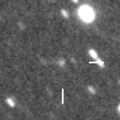
|
Now it is 17.8 mag (Mar. 31, iTelescope Observatory, Siding Spring). It will brighten up to 16.5 mag in June. It is observable in excellent condition in the Southern Hemisphere. It locates low in the Northern Hemisphere.
Date(TT) R.A. (2000) Decl. Delta r Elong. m1 Best Time(A, h)
May 25 17 37.37 -38 20.0 2.822 3.755 153 16.5 1:31 ( 0, 87)
June 1 17 18.51 -39 33.4 2.771 3.739 159 16.4 0:45 ( 0, 85)
|

|
Now it is 18.7 mag (May 7, Martin Masek). It will brighten rapidly up to 11.5 mag in autumn. In the Northern Hemisphere, it will be observable in excellent condition. In the Southern Hemisphere, it will be extremely low from autumn to winter.
Date(TT) R.A. (2000) Decl. Delta r Elong. m1 Best Time(A, h)
May 25 22 52.71 -21 11.5 1.584 1.835 87 17.2 5:25 (237, 68)
June 1 23 8.35 -19 26.7 1.485 1.791 89 16.8 5:29 (226, 69)
|

|
Now it is 16.8 mag (May 11, M. Suzuki, B. Lutkenhoner). It will brighten up to 16 mag from June to August, and it will be observable in excellent condition in the Northern Hemisphere. It is not observable in the Southern Hemisphere.
Date(TT) R.A. (2000) Decl. Delta r Elong. m1 Best Time(A, h)
May 25 0 16.76 54 12.8 2.269 1.866 54 17.0 5:25 (203, -6)
June 1 0 17.32 59 4.8 2.156 1.834 58 16.8 5:29 (197, -8)
|

|
Now it is 17.3 mag (May 4, Toshihiko Ikemura, Hirohisa Sato). It stays 16-17 mag for a long time until 2020. It is observable in good condition in the Northern Hemisphere. It is not observable at all in the Southern Hemisphere.
Date(TT) R.A. (2000) Decl. Delta r Elong. m1 Best Time(A, h)
May 25 10 50.28 67 41.4 8.667 8.461 75 16.8 18:40 (180,-13)
June 1 10 52.82 66 48.4 8.726 8.464 71 16.8 18:26 (179,-12)
|

|
Now it is 16.4 mag (May 7, Toshihiko Ikemura, Hirohisa Sato). It is observable at 17 mag in good condition in 2019. It locates somewhat low in the Northern Hemisphere.
Date(TT) R.A. (2000) Decl. Delta r Elong. m1 Best Time(A, h)
May 25 15 28.63 -15 35.8 2.883 3.885 169 16.9 23:17 (180, 71)
June 1 15 24.23 -15 29.5 2.914 3.893 162 16.9 22:45 (180, 71)
|

|
Now it is 16.6 mag (May 3, Toshihiko Ikemura, Hirohisa Sato). It is expected to be observable at 5-6 mag for a long time from 2022 to 2023. In the Northern Hemisphere, it is not observable at the highlight from 2022 summer to 2023 summer. In the Southern Hemisphere, it stays unobservable for a while. But it will be observable in good condition at the highlight.
Date(TT) R.A. (2000) Decl. Delta r Elong. m1 Best Time(A, h)
May 25 17 55.92 58 29.9 11.437 11.611 97 16.9 1:48 (180, -3)
June 1 17 51.75 58 38.7 11.384 11.565 97 16.9 1:16 (180, -4)
|

|
It has not been observed yet in this apparition. It will be observable at 16 mag in good condition from summer to autumn. It locates somewhat low in the Southern Hemisphere.
Date(TT) R.A. (2000) Decl. Delta r Elong. m1 Best Time(A, h)
May 25 0 35.08 8 17.7 2.481 2.023 52 17.2 5:25 (234, 29)
June 1 0 49.19 10 1.2 2.423 2.018 54 17.0 5:29 (229, 30)
|

|
Now it is 16.8 mag (May 23, G. Hug). It will brighten up to 14 mag in winter. It stays observable for a long time in the Southern Hemisphere. It is observable only until early August in the Northern Hemisphere.
Date(TT) R.A. (2000) Decl. Delta r Elong. m1 Best Time(A, h)
May 25 17 4.06 -26 6.3 2.621 3.610 165 17.2 0:57 (180, 81)
June 1 16 52.38 -27 23.7 2.542 3.551 173 17.0 0:18 (180, 82)
|
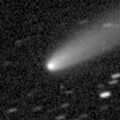
|
It brightened up to 13.2 mag from December to March (Dec. 30, Chris Wyatt). Now it is fading. It has already faded down to 16.6 mag (May 3, Toshihiko Ikemura, Hirohisa Sato). It will be fainter than 18 mag in June.
Date(TT) R.A. (2000) Decl. Delta r Elong. m1 Best Time(A, h)
May 25 11 41.29 -2 54.8 1.625 2.231 113 17.1 19:31 (180, 58)
June 1 11 47.97 -3 19.3 1.736 2.272 108 17.4 19:10 (180, 58)
|

|
Now it is 17.7 mag (May 16, M. Masek). It will brighten up to 17 mag from June to July, and will be observable in good condition.
Date(TT) R.A. (2000) Decl. Delta r Elong. m1 Best Time(A, h)
May 25 19 56.43 -30 25.8 1.730 2.480 127 17.6 3:49 (180, 85)
June 1 19 32.37 -29 13.0 1.601 2.459 139 17.4 2:58 (180, 84)
|

|
It has not been observed yet in this apparition. It is expected to brighten up to 12 mag from August to September. It is observable in good condition in the Northern Hemisphere. It will be low around the high light in the Southern Hemisphere.
Date(TT) R.A. (2000) Decl. Delta r Elong. m1 Best Time(A, h)
May 25 0 10.37 -11 43.4 1.698 1.587 66 18.2 5:25 (247, 48)
June 1 0 28.41 -8 40.7 1.624 1.549 67 17.5 5:29 (240, 48)
|

|
In the Southern Hemisphere, it is observable at 17.5 mag in good condition from spring to summer. In the Northern Hemisphere, it is not observable at all. It has not been observed since last September.
Date(TT) R.A. (2000) Decl. Delta r Elong. m1 Best Time(A, h)
May 25 16 54.29 -57 19.4 3.544 4.390 142 17.7 0:48 ( 0, 68)
June 1 16 47.58 -57 15.3 3.524 4.390 144 17.7 0:14 ( 0, 68)
|
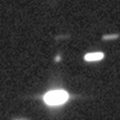
|
Now it is 17.5 mag (May 3, Toshihiko Ikemura, Hirohisa Sato). It is expected to brighten up to 13.5 mag in 2021, and it will be observable in good condition in the Southern Hemisphere. In the Northern Hemisphere, it is not observable at the highlight.
Date(TT) R.A. (2000) Decl. Delta r Elong. m1 Best Time(A, h)
May 25 13 45.66 7 56.0 6.525 7.280 135 17.7 21:35 (180, 47)
June 1 13 42.89 7 39.6 6.557 7.235 128 17.7 21:04 (180, 47)
|

|
Now it is 17.4 mag (May 7, Toshihiko Ikemura, Hirohisa Sato). It will brighten up to 17.5 mag from June to July.
Date(TT) R.A. (2000) Decl. Delta r Elong. m1 Best Time(A, h)
May 25 20 16.65 -21 55.7 1.844 2.529 121 17.9 4:09 (180, 77)
June 1 20 20.58 -23 13.6 1.793 2.545 127 17.8 3:45 (180, 78)
|

|
It has not been observed yet in this apparition. Now it is fainter than 21.5 mag (Mar. 10, Erwin Schwab). It will be observable at 17.5 mag from June to August.
Date(TT) R.A. (2000) Decl. Delta r Elong. m1 Best Time(A, h)
May 25 18 58.57 -8 52.7 1.338 2.187 136 18.0 2:51 (180, 64)
June 1 18 58.81 -9 4.4 1.276 2.172 142 17.9 2:24 (180, 64)
|

|
It approached to Earth down to 0.08 a.u. in mid December, and it brightened up to 3.4 mag (Dec. 14, Seiichi Yoshida). it looked so large as 3 times of Moon. Now it is fading. It has already faded down to 17.6 mag (Apr. 27, Toshihiko Ikemura, Hirohisa Sato). In the Northern Hemisphere, it stays observable in excellent condition. It locates low in the Southern Hemisphere.
Date(TT) R.A. (2000) Decl. Delta r Elong. m1 Best Time(A, h)
May 25 10 59.20 21 5.1 1.849 2.176 94 17.9 18:49 (180, 34)
June 1 11 7.85 19 27.2 1.982 2.233 90 18.4 18:31 (180, 36)
|
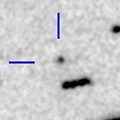
|
Now it is 18.0 mag (Apr. 27, Toshihiko Ikemura, Hirohisa Sato). It brightens up to 18 mag and it is observable in good condition from April to June. It locates somewhat low in the Southern Hemisphere.
Date(TT) R.A. (2000) Decl. Delta r Elong. m1 Best Time(A, h)
May 25 13 52.46 29 29.3 2.052 2.710 120 17.9 21:41 (180, 26)
June 1 13 51.80 28 44.8 2.118 2.721 116 18.0 21:13 (180, 26)
|
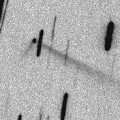
|
Main-belt asteroid. But it shows a straight tail like a comet. Now it is 18.1 mag (May 2, Toshihiko Ikemura, Hirohisa Sato). It stays observable in excellent condition until early summer.
Date(TT) R.A. (2000) Decl. Delta r Elong. m1 Best Time(A, h)
May 25 10 25.87 9 16.8 1.901 2.178 91 18.3 18:28 (176, 46)
June 1 10 34.07 9 30.1 1.970 2.162 86 18.4 18:26 (170, 45)
|
|
![]()
 C/2018 KJ3 ( Lemmon )
C/2018 KJ3 ( Lemmon ) 260P/McNaught
260P/McNaught C/2019 J2 ( Palomar )
C/2019 J2 ( Palomar ) C/2010 U3 ( Boattini )
C/2010 U3 ( Boattini ) 74P/Smirnova-Chernykh
74P/Smirnova-Chernykh C/2017 K2 ( PanSTARRS )
C/2017 K2 ( PanSTARRS ) 261P/Larson
261P/Larson C/2019 K1 ( ATLAS )
C/2019 K1 ( ATLAS ) 60P/Tsuchinshan 2
60P/Tsuchinshan 2 C/2019 J3 ( ATLAS )
C/2019 J3 ( ATLAS ) 168P/Hergenrother
168P/Hergenrother 186P/Garradd
186P/Garradd C/2019 F1 ( ATLAS-Africano )
C/2019 F1 ( ATLAS-Africano ) C/2019 J1 ( Lemmon )
C/2019 J1 ( Lemmon ) P/2012 K3 ( Gibbs )
P/2012 K3 ( Gibbs ) 46P/Wirtanen
46P/Wirtanen 149P/Mueller 4
149P/Mueller 4 (6478) Gault
(6478) Gault![]()




























